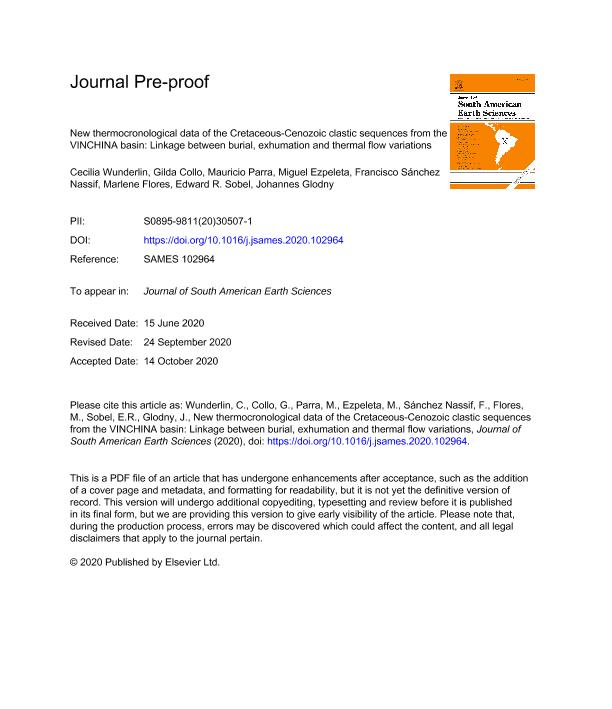Mostrar el registro sencillo del ítem
dc.contributor.author
Wunderlin, Cecilia Ayelén

dc.contributor.author
Collo, Gilda

dc.contributor.author
Parra, Mauricio
dc.contributor.author
Ezpeleta, Miguel

dc.contributor.author
Sánchez Nassif, Francisco Gabriel Antonio

dc.contributor.author
Flores, Marlene

dc.contributor.author
Sobel, Edward Robert

dc.contributor.author
Glodny, Johannes

dc.date.available
2021-09-22T16:32:44Z
dc.date.issued
2021-01
dc.identifier.citation
Wunderlin, Cecilia Ayelén; Collo, Gilda; Parra, Mauricio; Ezpeleta, Miguel; Sánchez Nassif, Francisco Gabriel Antonio; et al.; New thermocronological data of the Cretaceous-Cenozoic clastic sequences from the VINCHINA basin: Linkage between burial, exhumation and thermal flow variations; Pergamon-Elsevier Science Ltd; Journal of South American Earth Sciences; 105; 1-2021; 1-36; 102964
dc.identifier.issn
0895-9811
dc.identifier.uri
http://hdl.handle.net/11336/141198
dc.description.abstract
New apatite fission track (AFT) and (U–Th)/He (AHe) data from two sections recording Cretaceous-Cenozoic clastic successions (La Flecha - La Troya Sur creeks) in the northern sector of the Central Precordillera of Argentina are presented. The results show that the Ciénaga del Río Huaco, Puesto la Flecha and Vallecito Fms. would have crossed the 60 °C isotherm during burial, while the middle sector of the Vinchina Fm. would not have reached temperatures higher than 55 °C. Multimethod inverse thermal modeling suggests that the AFT ages of all the studied levels would not have been completely reset and allow inferring that the partial retention zone for the AHe system (AHe-PRZ) would have been reached during the Miocene in levels between the Vallecito and Vinchina Fms. Our 1D-modeling results for the Ciénaga del Río Huaco, Puesto la Flecha and Vallecito Fms. show that the maximum temperature would have been reached at ~15 Ma, with a sedimentary thickness of ~2750 m and a heat flow of 65 mW/m2. From these data, a geothermal gradient of ~27 °C/km at this time could be inferred. In turn, the Vinchina and Zapallar Fms. would have reached their maximum temperature at ~2 Ma, under a cooler thermal regime (20 mW/m2) and with an estimated geothermal gradient of <15 °C/km. Thus, a complex time-temperature trajectory is proposed. Maximum and cooling temperatures reached by each unit do not correspond in all cases to the maximum burial and exhumation times. Comparison of the thermal modelling from this work with those carried out by other authors for sections immediately to the north allows us to infer that the thermal regime within the Vinchina basin has important lateral variations. Finally, AFT and AHe analyzes carried out in this work constitute a baseline database of the thermal regime, which is necessary for future multiproxies studies that are being done to evaluate the preservation of primary thermal signals, and thus check their reliability for pealeoclimatic and paleoenvironmental interpretations.
dc.format
application/pdf
dc.language.iso
eng
dc.publisher
Pergamon-Elsevier Science Ltd

dc.rights
info:eu-repo/semantics/openAccess
dc.rights.uri
https://creativecommons.org/licenses/by-nc-nd/2.5/ar/
dc.subject
(U–TH)/HE
dc.subject
AFT
dc.subject
CRETACEOUS-CENOZOIC SEDIMENTARY BASIN
dc.subject
INVERSE THERMAL MODELING
dc.subject
THERMAL REGIME
dc.subject
VINCHINA BASIN
dc.subject.classification
Geociencias multidisciplinaria

dc.subject.classification
Ciencias de la Tierra y relacionadas con el Medio Ambiente

dc.subject.classification
CIENCIAS NATURALES Y EXACTAS

dc.title
New thermocronological data of the Cretaceous-Cenozoic clastic sequences from the VINCHINA basin: Linkage between burial, exhumation and thermal flow variations
dc.type
info:eu-repo/semantics/article
dc.type
info:ar-repo/semantics/artículo
dc.type
info:eu-repo/semantics/publishedVersion
dc.date.updated
2021-09-06T15:10:00Z
dc.journal.volume
105
dc.journal.pagination
1-36; 102964
dc.journal.pais
Estados Unidos

dc.description.fil
Fil: Wunderlin, Cecilia Ayelén. Consejo Nacional de Investigaciones Científicas y Técnicas. Centro Científico Tecnológico Conicet - Córdoba. Centro de Investigaciones en Ciencias de la Tierra. Universidad Nacional de Córdoba. Facultad de Ciencias Exactas Físicas y Naturales. Centro de Investigaciones en Ciencias de la Tierra; Argentina
dc.description.fil
Fil: Collo, Gilda. Consejo Nacional de Investigaciones Científicas y Técnicas. Centro Científico Tecnológico Conicet - Córdoba. Centro de Investigaciones en Ciencias de la Tierra. Universidad Nacional de Córdoba. Facultad de Ciencias Exactas Físicas y Naturales. Centro de Investigaciones en Ciencias de la Tierra; Argentina
dc.description.fil
Fil: Parra, Mauricio. Universidade de Sao Paulo; Brasil
dc.description.fil
Fil: Ezpeleta, Miguel. Consejo Nacional de Investigaciones Científicas y Técnicas. Centro Científico Tecnológico Conicet - Córdoba. Centro de Investigaciones en Ciencias de la Tierra. Universidad Nacional de Córdoba. Facultad de Ciencias Exactas Físicas y Naturales. Centro de Investigaciones en Ciencias de la Tierra; Argentina
dc.description.fil
Fil: Sánchez Nassif, Francisco Gabriel Antonio. Consejo Nacional de Investigaciones Científicas y Técnicas. Centro Científico Tecnológico Conicet - Córdoba. Centro de Investigaciones en Ciencias de la Tierra. Universidad Nacional de Córdoba. Facultad de Ciencias Exactas Físicas y Naturales. Centro de Investigaciones en Ciencias de la Tierra; Argentina
dc.description.fil
Fil: Flores, Marlene. Universidade de Sao Paulo; Brasil
dc.description.fil
Fil: Sobel, Edward Robert. Universitat Potsdam; Alemania
dc.description.fil
Fil: Glodny, Johannes. Universitat Potsdam; Alemania
dc.journal.title
Journal of South American Earth Sciences

dc.relation.alternativeid
info:eu-repo/semantics/altIdentifier/url/https://www.sciencedirect.com/science/article/abs/pii/S0895981120305071
dc.relation.alternativeid
info:eu-repo/semantics/altIdentifier/doi/http://dx.doi.org/10.1016/j.jsames.2020.102964
Archivos asociados
